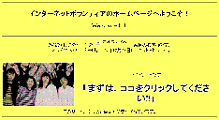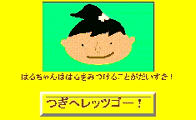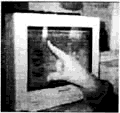Conference to introduce results from the 100-School Networking Project (Phase
II)
Elementary school meeting
Using the Internet at a School for the Handicapped
—A Simple, Friendly, and Practical Networking System—
Masato Mizuno, School for the mentaly retarded attached
to the faculty of education, Fukui University
1. Introduction
- Students at our school present a wide range of handicaps of varying severity.
As part of the 100-School Networking Project, which started in FY 1995, we
conducted a trial project of e-mail exchange with students we met during school
trips and people in the field of education from all over Japan. But maintaining
this exchange was made difficult by the poor grasp of our students of the
relation between their various e-mail correspondents and the faces and identities
of real people behind them. We felt that networking for the mentally handicapped
might be more familiar, and easier for them to understand and use.
In FY 1997, we decided to join Challenge Kids, a membership system network
created for special education that is free to children. This system protects
their privacy, allows them to become familiar with networking by sharing common
interests, and increases their skills in self-expression. We believed that
local information would be easier for them to understand, attract and hold
their interest, and be useful in their everyday lives. We solicited volunteers
among students at Faculty of Education of Fukui University, Course for Information
and Socio-cultural Studies and asked them to create a web site presenting
information familiar to children at our school, including personal information.
We met in person and got acquainted, to provide our students with real-life
counterparts to their on-line correspondents. We also tried to ease access
and navigation for this web site and other web sites by preparing touch panels
for students, some of whom had difficulty navigating a networking system because
of poor mouse manipulation skills.
2. Our current situation and equipment
- Our equipment consists of one server and twelve personal computers (two
are used, one is for office work, and eight are notebook-sized), connected
to a 64 kbps leased line.
As of FY 1997, students from the computer club use computers on their own
about three times a week after school, outside of regular club classes.
3. Activities in FY 1997
- (1) Joining Challenge Kids
Challenge Kids is a membership system network for special schools
and classes all over Japan, run mainly by Special School for the Mentally
Handicapped, Affiliated to Faculty of Education, Shiga University, which is
designated by the Ministry of Education to conduct research on the use of
computers over the term FY 1996 and 97. Twenty-seven schools participate and
conduct research as a team.
Our school joined this network in FY 1997. A friendly and fun user interface
keeps the students interested and encourages them to continue exchanging e-mail
and pictures.
(2) Interaction with volunteers, including face-to-face meetings, and providing
information to enhance children's daily lives
- Although we first planned to send information to the children by e-mail,
including pictures, we chose in the end to create a web site, in order to
reach as many people as possible. During preparations, we invited our volunteers
to meet and get to know students from our computer club. Our web site includes
an information page describing daily life, with images created by the volunteers,
a page where children can request information and home pages they're interested
in seeing, and a story page where children can use touch panels.


(3) Improving access to web sites through touch panels
 For children
who have difficulty using a mouse, we tried to ease access to interesting
web sites, including the site created by our student volunteers, by using
a touch panel. We obtained permission to use images from other home pages
and put them on a local page (not our school's home page), so that students
could access them just by touching the image. Touch panels are easy to understand
and use. Some children even remembered to press the browser return button
on the second time they used it, and were able to retrieve information on
their own.
For children
who have difficulty using a mouse, we tried to ease access to interesting
web sites, including the site created by our student volunteers, by using
a touch panel. We obtained permission to use images from other home pages
and put them on a local page (not our school's home page), so that students
could access them just by touching the image. Touch panels are easy to understand
and use. Some children even remembered to press the browser return button
on the second time they used it, and were able to retrieve information on
their own.
4. Individual examples from the past three years
(1) E-mail and network conferencing (Student A, high school third grader)
 She became
interested in e-mail after seeing a friend using it. She started by exchanging
her daily diary with a friend at her school, successfully remembering her
own password to access e-mail and teaching word processing to her friends.
She exchanged e-mail with several correspondents, including a college student
in Shizuoka prefecture. She sent and received lots of e-mail, sometimes writing
them after school. She also became interested in real-time voice exchange,
using network conferencing software, and enjoyed chatting and drawing with
friends.
She became
interested in e-mail after seeing a friend using it. She started by exchanging
her daily diary with a friend at her school, successfully remembering her
own password to access e-mail and teaching word processing to her friends.
She exchanged e-mail with several correspondents, including a college student
in Shizuoka prefecture. She sent and received lots of e-mail, sometimes writing
them after school. She also became interested in real-time voice exchange,
using network conferencing software, and enjoyed chatting and drawing with
friends.
(2) Sending your own drawings by computer (Student B, high school third
grader)
 This
student, who enjoyed drawing, joined the computer club (after school) in the
middle of 1996. After we sent his pictures to people who applied to our Christmas
e-mail project, some schools put his drawings on their home pages. He continued
to draw after we joined Challenge Kids, sending his work to "Small Museum,"
one of their pages. All this made him more aware of the interest many people
had in his work and motivated to keep drawing. The praise he received for
his drawings gave him confidence and self-esteem. He enjoyed the idea that
people would use his work in various ways. He also got much pleasure from
choosing colors and lettering fonts when sending e-mail. He drew pictures
for each student from Fukui University who had volunteered to help with our
project.
This
student, who enjoyed drawing, joined the computer club (after school) in the
middle of 1996. After we sent his pictures to people who applied to our Christmas
e-mail project, some schools put his drawings on their home pages. He continued
to draw after we joined Challenge Kids, sending his work to "Small Museum,"
one of their pages. All this made him more aware of the interest many people
had in his work and motivated to keep drawing. The praise he received for
his drawings gave him confidence and self-esteem. He enjoyed the idea that
people would use his work in various ways. He also got much pleasure from
choosing colors and lettering fonts when sending e-mail. He drew pictures
for each student from Fukui University who had volunteered to help with our
project.
5. Conclusion
- We had no computer club before we joined the 100-School Networking Project.
Neither children nor teachers were familiar with computers. We've struggled
throughout this project, and haven't yet reached the level where we can return
the fruits of our labor to teachers and children. We'd like to be able to
make the network more an everyday, routine part of our lives, and go beyond
the stage where the primary focus is on learning how to use it.
If we continue as project participants, I would like to add more information
to our school's home page, broaden teacher use of the network, and increase
the number of volunteers from various walks of life who can provide information
to help children improve their lives, and establish an Internet volunteer
network. Hopefully, we'll be able to use web sites created by people outside
our school. We need to do more research into networking systems that suit
individual needs, while monitoring the progress of technology.
Words of gratitude
- Information-Technology Promotion Agency, Japan (IPA), Center for Educational
Computing (CEC), Fukui prefecture Ishikawa prefecture Toyama prefecture regional
network (FITNET), and Information Processing Center of Fukui University all
provided essential support in creating our network, including information
on using a leased line. Mr. Miyashita from the Faculty of Education at Fukui
University helped us connect our computers to the Internet, and Mr. Tsukamoto
from the Faculty of Education at Fukui University has helped us contact and
organize Internet volunteers. We would like to express our thanks to all these
persons and institutions.
 Conference to introduce results from the 100-School Networking Project (Phase II)
Conference to introduce results from the 100-School Networking Project (Phase II)




 For children
who have difficulty using a mouse, we tried to ease access to interesting
web sites, including the site created by our student volunteers, by using
a touch panel. We obtained permission to use images from other home pages
and put them on a local page (not our school's home page), so that students
could access them just by touching the image. Touch panels are easy to understand
and use. Some children even remembered to press the browser return button
on the second time they used it, and were able to retrieve information on
their own.
For children
who have difficulty using a mouse, we tried to ease access to interesting
web sites, including the site created by our student volunteers, by using
a touch panel. We obtained permission to use images from other home pages
and put them on a local page (not our school's home page), so that students
could access them just by touching the image. Touch panels are easy to understand
and use. Some children even remembered to press the browser return button
on the second time they used it, and were able to retrieve information on
their own.  She became
interested in e-mail after seeing a friend using it. She started by exchanging
her daily diary with a friend at her school, successfully remembering her
own password to access e-mail and teaching word processing to her friends.
She exchanged e-mail with several correspondents, including a college student
in Shizuoka prefecture. She sent and received lots of e-mail, sometimes writing
them after school. She also became interested in real-time voice exchange,
using network conferencing software, and enjoyed chatting and drawing with
friends.
She became
interested in e-mail after seeing a friend using it. She started by exchanging
her daily diary with a friend at her school, successfully remembering her
own password to access e-mail and teaching word processing to her friends.
She exchanged e-mail with several correspondents, including a college student
in Shizuoka prefecture. She sent and received lots of e-mail, sometimes writing
them after school. She also became interested in real-time voice exchange,
using network conferencing software, and enjoyed chatting and drawing with
friends.  This
student, who enjoyed drawing, joined the computer club (after school) in the
middle of 1996. After we sent his pictures to people who applied to our Christmas
e-mail project, some schools put his drawings on their home pages. He continued
to draw after we joined Challenge Kids, sending his work to "Small Museum,"
one of their pages. All this made him more aware of the interest many people
had in his work and motivated to keep drawing. The praise he received for
his drawings gave him confidence and self-esteem. He enjoyed the idea that
people would use his work in various ways. He also got much pleasure from
choosing colors and lettering fonts when sending e-mail. He drew pictures
for each student from Fukui University who had volunteered to help with our
project.
This
student, who enjoyed drawing, joined the computer club (after school) in the
middle of 1996. After we sent his pictures to people who applied to our Christmas
e-mail project, some schools put his drawings on their home pages. He continued
to draw after we joined Challenge Kids, sending his work to "Small Museum,"
one of their pages. All this made him more aware of the interest many people
had in his work and motivated to keep drawing. The praise he received for
his drawings gave him confidence and self-esteem. He enjoyed the idea that
people would use his work in various ways. He also got much pleasure from
choosing colors and lettering fonts when sending e-mail. He drew pictures
for each student from Fukui University who had volunteered to help with our
project. Conference to introduce results from the 100-School Networking Project (Phase II)
Conference to introduce results from the 100-School Networking Project (Phase II)